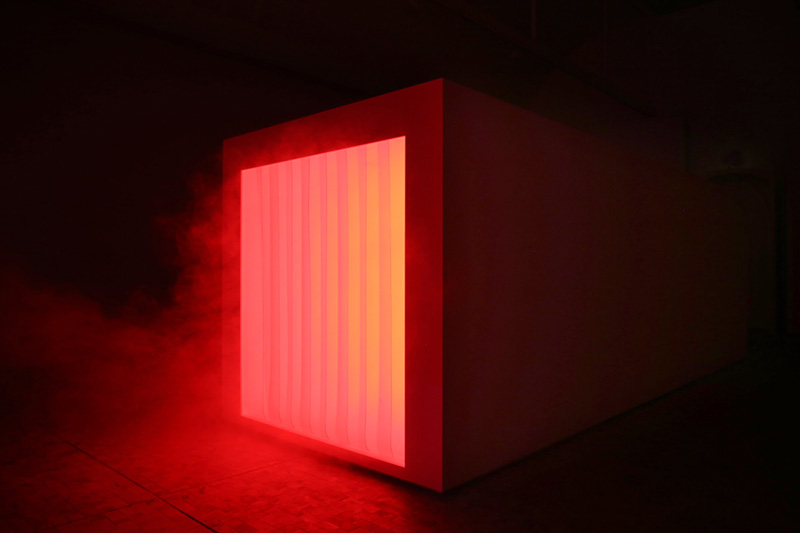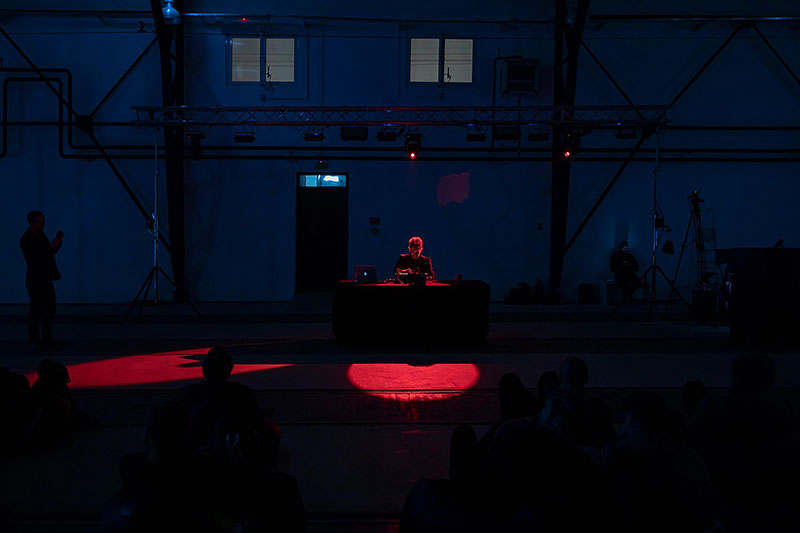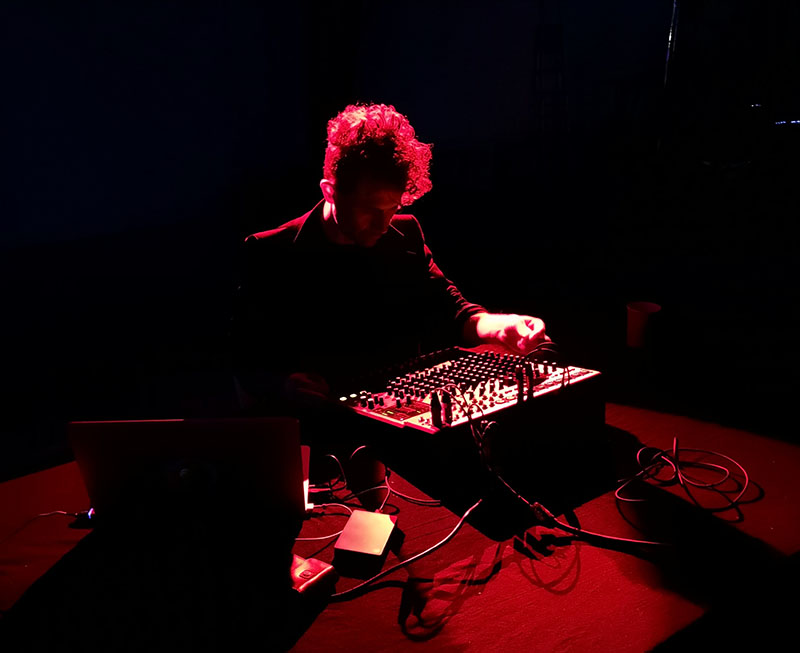The work of Jacob Kirkegaard explores ways to reflect on complex, unnoticed or unapproachable conditions and environments. His works have treated themes such as radioactivity in Chernobyl, melting ice in the Arctic, border walls in global and metaphorical contexts, immersive acoustic explorations into global waste management, and processes related to when a human being dies. Using his recordings of firearms, grenades and tanks his recent work explores the sound of warfare orchestrated for the Royal Lifeguard's Music Corps. Another recent work unfolds the mechanical elements of agriculture and food production. Since 2006 Kirkegaard has also been extensively researching, recording and creating works using otoacoustic emissions; tones generated from the actual human ear.
The core element and method of Jacob Kirkegaard's work derive from the use of sound recordings of the tangible aspects from its intangible themes.

________________________________________________________________________________
The work of Jacob Kirkegaard (born in Denmark, 1975) explores ways to reflect on complex, unnoticed or unapproachable conditions and environments. In 1981, at the age of six, Kirkegaard made his first sound recordings and in 1994 he was introduced to the world of sound art.
His works have treated themes such as radioactivity in Chernobyl, melting ice in the Arctic, border walls in global and metaphorical contexts, immersive acoustic explorations into global waste management, and processes related to when a human being dies. Using his recordings of firearms, grenades and tanks his most recent work explores the sound of warfare orchestrated for the Royal Lifeguard's Music Corps. His current work listens to the mechanical elements of agriculture and food production. Since 2006 Kirkegaard has also been extensively researching, recording and creating works using otoacoustic emissions; tones generated from the actual human ear. The core element and method of Jacob Kirkegaard's work derive from the use of sound recordings of the tangible aspects from its intangible themes.
Kirkegaard's sound works have been released on labels such as Touch (UK) and Important Records (USA). He is a founding member of the sound art collective freq_out as well as the not-for-profit arts organisation TOPOS. Jacob has presented his works at galleries, museums, biennales and concert spaces throughout the world, including MoMA in New York, LOUISIANA - Museum of Modern Art and ARoS in Denmark, The Menil Collection and at the Rothko Chapel in Houston, The Sydney Biennale in Australia, Aichi Triennale in Nagoya, the Mori Art Museum in Tokyo, Japan. He has gallery representation through Fridman Gallery (New York, USA) and Galleri Tom Christoffersen (Copenhagen, DK). His work is in the collections of LOUISIANA - Museum of Modern Art and at ARoS Aarhus Art Museum, Museum Sønderjylland in Denmark, and Bell Gallery at Brown University, USA. Jacob has collaborated with artists such as CM von Hauswolff, Philip Jeck, JG Thirlwell, Phill Niblock, Else Marie Pade, Gry Bagøien, Leif Elggren and Lydia Lunch. Since 2013 he has been extensively collaborating with Julie Martin (born 1938 and director of E.A.T.). In 2022 Jacob Kirkegaard received the Eckersberg Medal from the Royal Danish Academy of Fine Arts (Akademiraadet) in recognition of outstanding achievements in the arts.
Between 2001 and 2005 Jacob Kirkegaard obtained an MA from the Academy of Media Arts in Cologne, Germany where he studied under Siegfried Zielinski and Anthony Moore. In 2016 Kirkegaard was the sound-artist-in-residency at St. John's College, University of Oxford, U.K. In 2022 Jacob was appointed a guest professorship at the School of Music, Johannes Gutenberg University in Mainz, Germany where he was teaching and conducting research on sound of the internet, or the mechanical Cloud as the newly trusted storage facility for basically everything. In 2018 Jacob collaborated with Nairobi-based UN-HABITAT’s Waste Wise Cities Programme to create a series of works related to global challenges of waste management and informal waste sectors. The collaboration continued in 2022 and 2023 when employed by the United Nation's Waste Wise Cities Programme as a sound recordist as well as a consultant, providing awareness raising materials for the global plastic treaty, currently being negotiated between the countries of the global community.
________________________________________________________________________________
The Wire: Sitting amid the 8-channel audio, one hears incredible details, and there’s a timelessness that breaks from the sequenced motion of the video. It’s peaceful, even sensual (…) - the audio has a sharp, cleansing purity. It’s beautifully crafted, and the 8-channels create the sonic illusion of a depth and breath to the space that goes far past the walls, ceiling and floor of the room. (…) If there’s dread in hearing the environment swamped by the wastefulness of consumer capitalism, it’s that of the sublime. George Grella, 2021
The New York Times: The recording locations of the Danish sound artist Jacob Kirkegaard are especially poetic: His albums have revealed the empty rooms of Chernobyl, the inside of morgues and the otoacoustic emissions of his own inner ear. Christopher R. Weingarten, 2020
Rolling Stone: One of contemporary sound art's most subtle, intriguing figures. More artistically minded than field recordings, more naturally hewn than noise tapes, Kirkegaard amplifies hidden worlds into evocative drifts. December 2015
Douglas Kahn: Kirkegaard has countered Duchamp’s dictum, “One can look at seeing, one can’t hear hearing.” Earside Out, 2014
The Wire: For all the scientific rigour to Kirkegaard's research into the sonic possibilities of various materials, his work reveals an underlying fascination for the mysteries and myths embedded in them. His work channels an access to an inner world. Anne Hilde Neset, 2009
________________________________________________________________________________
WATCH
Sometimes in makes no sense to explain one's own work
Artist talk: Jacob Kirkegaard, Danish Sound Artist: "The Sound of Waste"
Association of Jersey Architects / AJA Public Talks
December 2023
When I listen, I have to be quiet. Sound Artist Jacob Kirkegaard
LOUISIANA CHANNEL, September 2021
Portrait of artist Jacob Kirkegaard and the making of TESTIMONIUM
This portrait was created by John Grzinich in Spring of 2019 on ocassion of the
exhibition "NOT out of sight, NOT out of mind"
________________________________________________________________________________
THE WIRE - TESTIMONIUM at Fridman Gallery, New York, USA, UK, April 2021
BOMB MAGAZINE - Listening to the Heart: Jacob Kirkegaard Interviewed by Julie Martin, USA, March 2021
FLASH ART - Decaying Sound, Sounding Decay: Jacob Kirkegaard, USA, March 2021
NATIONAL SAWDUST - Jacob Kirkegaard: Creating for Awareness with Sound, USA, December 2019
ENDÉMICO - Explorando la Musicalidad en la Naturaleza, Chile, Noviembre 2019
INFORMATION - Testimonium, Denmark, November 2019
KRISTELIGT DAGBLAD - Jacob Kirkegaard: Kender de Dødes Lyde, Denmark, May 2019
INFORMATION - Hjernen er Porøs, Denmark, May 2019
WAVES - SOUND AND VIBRATION NEWS - There and Back Again - An Artist's Tale, Denmark, December 2019
________________________________________________________________________________
AUDIO FEATURES
SOUNDS OF DEATH by Tim Hinman / Third Ear, 2019
On Jacob Kirkegaard's Opus Mors project
CLICK HERE FOR ALL COLLECTED AUDIO FEATURES
________________________________________________________________________________
________________________________________________________________________________
________________________________________________________________________________
________________________________________________________________________________
________________________________________________________________________________
copyright © jacob kirkegaard
all rights reserved
fonik.dk | 2002



